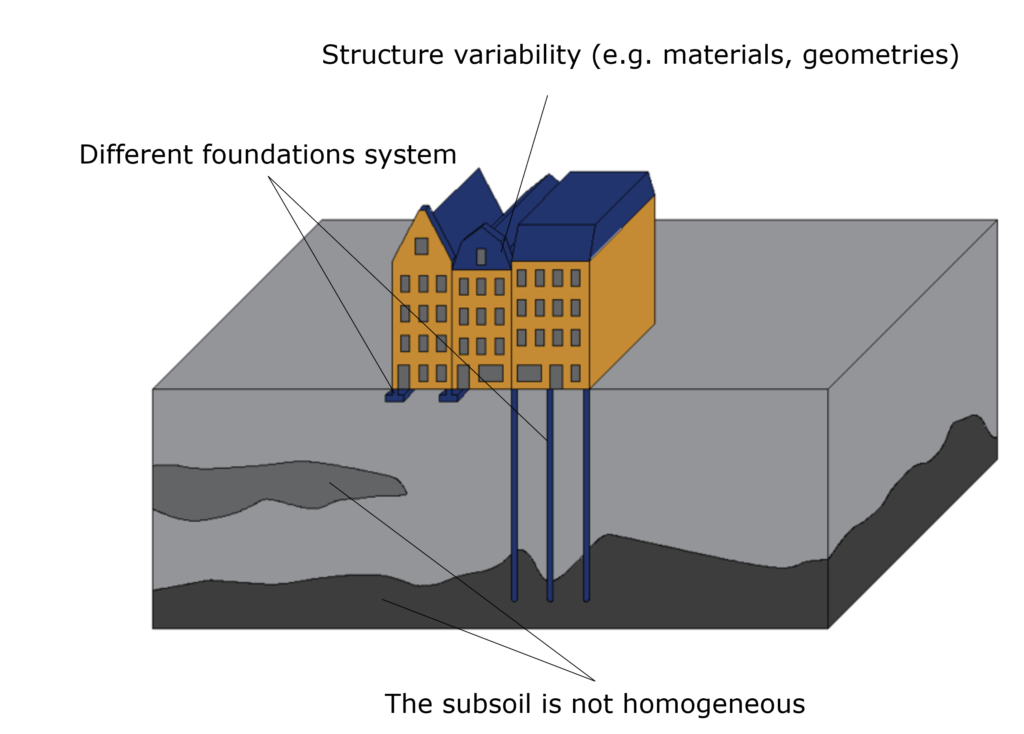WP3.2 – Assessment of subsidence induced damage on masonry buildings
Assessment of subsidence induced damage on masonry buildings
In the Netherlands, many (historical) unreinforced masonry (URM) buildings suffer from ground deformations associated with subsidence. The subsidence-related settlements are highly influenced by the soil heterogeneities, the groundwater regime, and the loading conditions of buildings resting on the subsoil system (Figure 1).

Figure 1. An illustration of the structure-foundation-subsurface system. Structures characterized by different features (e.g. materials, geometries, loading conditions) transmit the load to the heterogeneous subsurface on which they rest by means of different types of foundation systems.
Low-rise residential buildings (e.g. terraced and detached houses) represent the largest typologies of the Dutch building stock [1-9]. Such URM buildings on either unreinforced (i.e. masonry strips) or reinforced (i.e. concrete strips or raft) shallow foundations can be seriously affected by the ground movements.
The purpose of this study is to be able to assess the influence of the variability in the soil system, the building features and the groundwater regime on the building response in terms of damage. The results are expected to be valuable input to the consequential evaluation of subsidence risk adaptation and mitigation strategies for masonry buildings.
Objective of the research
When a structure is unable to accommodate the subsidence, cracking of structural or non-structural elements alike, tilting and distortions are likely to occur, leading to a loss of cosmetic, functional or structural aspects [10-12]. The purpose of this study is to be able to assess the influence of the variability in the soil subsurface, the building features and the groundwater regime on the building response in terms of damage.
Method of the research: numerical analyses of masonry buildings
A combination of subsidence drivers, such as the weight of structures, underground leaking pipes, broken sewers and malfunctioning drainage systems, tree roots or tree felling activities (inducing swelling in clayey soils), water table fluctuations due to seasonal or climate-induced effects, anthropogenic policies (e.g., due to deindustrialization), excavations, tunnelling and mining works lead to the occurrence of unpredictable ground settlement shapes [13, 14]. Although observations of real structures affected by settlements are key to achieving a better understanding of the damage occurrence, settlement data and damage surveys are often not available or incomplete.

Figure 2. An example of the crack pattern resulting from a 3D numerical model due to the application of the differential settlements. The crack width is shown in the figure.
Numerical analyses (Figure 2) offer the possibility to directly and objectively quantify the damage, and also provide the opportunity to evaluate the effect of different controlled variations. For example, the effect of different settlement configurations (e.g. “sagging” and/or “hogging” profiles) can be investigated [4].
The PhD candidate working in WP 3.2 is Alfonso Prosperi, supervised by Jan Rots (TUD), Mandy Korff (TUD / Deltares), and Paul Korswagen Eguren (TUD). The work has started on 1 October 2020.
Publications
Alfonso Prosperi, Paul A. Korswagen, Mandy Korff, Roel Schipper, Jan G. Rots Empirical fragility and ROC curves for masonry buildings subjected to settlements (2023) Journal of Building Engineering 68:106094, https://doi.org/10.1016/j.jobe.2023.106094.
Alfonso Prosperi, Michele Longo, Paul A. Korswagen, Mandy Korff, Jan G. Rots Sensitivity modelling with objective damage assessment of unreinforced masonry façades undergoing different subsidence settlement patterns (2023) Engineering Structures 286:116113, https://doi.org/10.1016/j.engstruct.2023.116113

